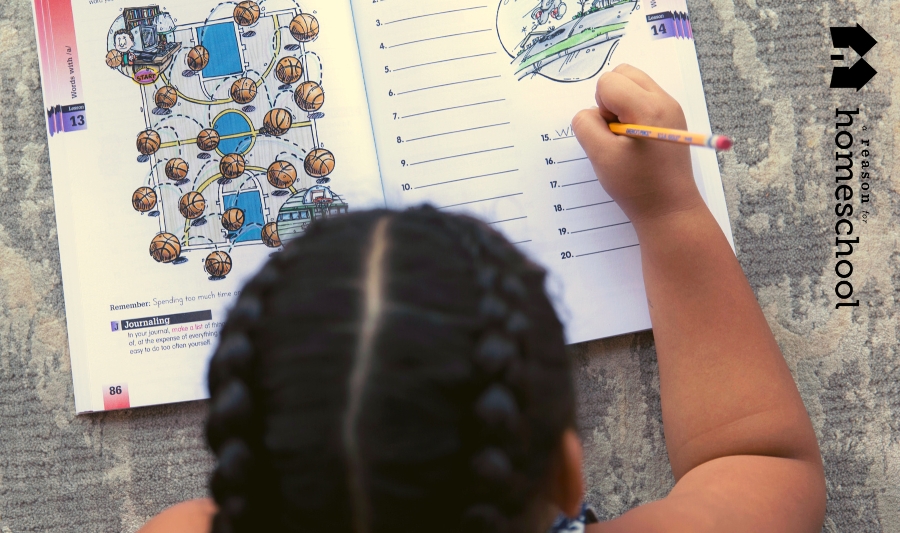Editor’s note: In today’s guest post, Tracy Glockle (of GrowingNGrace.com) shares an update on her experience with A Reason For Spelling. For the past several years, Tracy’s daughter, who struggles with dyslexia, has used the program and has seen remarkable improvement in her spelling skills and confidence. We hope you will find her story as moving and inspirational as we do.
For both my daughter and I, it was a pivotal memory. Once again, I sounded out the word “hurry” and she sounded it out with me. With tears in her eyes, she hesitantly put her pencil to her paper, tattered from failed attempts. Once more, the letters jumbled. There was a y and a w and an r and a few other random letters, the final word in no way resembling what we had just sounded out for the hundredth time. We closed the book, I gave her a hug, and we never reopened that book. It was the moment I realized my child would never learn to spell using phonics.
She had worked hard to read, and the phonics curriculum had worked marvelously to help her sort out her dyslexia on a page of words and read a story. But it just wasn’t working the same magic for spelling. We were both discouraged, and the only thing she was learning was to dread and fear the act of spelling and writing. I was ready to take some pretty drastic measures to ensure a different outcome.
We spent the next year working through a cognitive therapy program, training her to visually sort out the differences to complex patterns, art, and words. I did not touch a spelling book for the rest of that entire year or the next.
By the end of her third grade year, she had regained some confidence and trained her brain to look at letters and words differently. We both felt ready to tackle spelling again, but not the way we’d done it before. I began searching in earnest for a program that built from the cognitive therapy tools she’d gained and helped her to approach spelling visually. In God’s perfect way, He led me to A Reason For Spelling. The minute I looked at the sample pages online, I knew this was what she needed. It was visual, multi-sensory, and didn’t rely on phonics alone to teach the lesson. After carefully looking at placement, I started her in level C for her fourth grade year.
Over the next two years we worked through that one book. She took her time working through the various activities, studying the shapes of the words, creating art with the words, identifying misspelled words, and learning how her mind memorized. When she felt she had mastered a list, she would let me know, and we would use the “pretest” page at the beginning of the lesson as her spelling test. Her confidence grew and her pace became more consistent. For fourth and fifth grade she worked through the same book, taking about two weeks per lesson. And at the end of each lesson, she had mastered her list.
Lessons Learned from A Reason for Spelling
- She learned to engage with the words she was learning. In addition to the ideas her book provided, my daughter would ask for a variety of creative ways to practice. Could she use pipe cleaners or wikki stix to build her words? Absolutely! Could she build her own crossword with bananagram tiles? Of course! Could she trace them into a salt tray, and on the couch fabric? Sure! Sidewalk chalk? Yes. Dry erase board? You bet. Glitter glue? Ummm—okay.
- She recognized which choices and activities helped her most. We skipped pretests and dictation, anything that relied on auditory processing for spelling. Combining her two weakest areas together was a certain disaster. Instead we paired a weakness with a strength. The activities that worked from her strengths were the ones that most effectively helped her to spell. She narrowed her time to these specific activities and continued to rock her spelling lists.
- She turned a weakness into her favorite subject. When she made it to her first review lesson, she took a bright pink poster board and wrote every word she’d learned to spell and proudly hung it in her room. Success was very sweet! For three years now, A Reason for Spelling has continued to be her favorite subject, the subject she starts with each day. And this year, she skipped to the Level E book. We are still working slowly through the book, taking up to two weeks per lesson. She rarely misses more than two words on a spelling test, and aces them most of the time. And we’ve added a single dictation sentence as part of the end of the lesson spelling test.
- She has taken ownership of this subject. She chooses the activities, she practices her lesson, she lets me know when she’s mastered the words. By giving her control over it, she has been able to overcome her fear of failure. I discuss the phonics with her, and I administer the test at the end. That’s all I’ve ever done with this subject. She owns it! And her confidence in an area of weakness has been one of the greatest rewards of this curriculum.
Our Favorite Activities for Learning Spelling
- One of the most helpful activities for spelling is the first exercise of matching the shape of the spelling word to the left with the shape of the empty boxes to the right. This visual exercise really helps her to pay attention to what the word looks like. We talk over the phonics rules being used, and she understands them. But phonics is not the only tool in her toolbox. If she misses a word on her test, this is the activity we go back to. She writes the missed word and traces the boxes around each letter to visualize its shape.
- The activity of recognizing misspelled words is another favorite skill. Both she and I understand that she may never be able to spell every word in her head correctly, but with these regular exercises, she can identify misspelled words when she sees them in her writing and can correct them.
- As she has grown and matured, she no longer asks for crazy ways to practice her words. Most of the time, she selects one or two of the ideas in her book that she recognizes helps her the most. But this, to me, is another clear success: she has learned how she learns. These days, she enjoys practicing her words in her karaoke microphone or playing a concentration matching game. Sometimes, she will write her words on index cards and race her little brother (who has his own words written on cards) to see who can write the most correctly in one minute.
- The accompanying penmanship curriculum allows her to use her handwriting and spelling to bless others. When my pastor-husband makes a trip to visit someone sick or in the hospital, it’s not uncommon for my daughter to scramble to her folder and choose a handwritten Bible verse sheet she has worked on to give as a gift. This beautiful, simple approach to spelling and handwriting has given her the confidence to actually bless others with Scriptural encouragement rather than shamefully avoid writing. When I mention that confidence has been the greatest reward, this is the type of confidence I mean. I’ve seen my daughter do anything to avoid writing because of the shame of not knowing how to spell, and now I watch my daughter eagerly bless others with her creativity and sweet encouragement.
Why struggle through a learning disability to learn to spell? This curriculum very literally provided us with “a reason for” and an answer for our struggle with spelling. Watching my child give an area of weakness to the Lord and serve Him through it is priceless. It’s a reward I couldn’t have even articulated at the beginning of this journey. But when God answered my prayers—beyond anything I could ask or think—He led us to A Reason For.
Read more from Tracy HERE and HERE.

Tracy Glockle lives in Oregon and homeschools her crew of three kids with ADHD/dyslexia, finding creative ways to use their strengths to teach their weaknesses. Her life is creative chaos, and her homeschool is loud and busy and distracted and challenging and lovely. As a homeschooled homeschooler, she love customizing curriculum and making adjustments to incorporate fun, hands-on projects for out-of-the-box learners. Visit her at Growing In Grace to find grace for the messes and mistakes, and knowledge to pick up the pieces.
Want to learn more about A Reason For Spelling?
Our sponsor is offering a FREE sample lesson for each of the six levels in the program,
along with the corresponding A Reason For Handwriting lesson!
Download yours here:
Level A Sample Lessons — A Reason For Spelling & Handwriting
Level B Sample Lessons — A Reason For Spelling & Handwriting
Level C Sample Lessons — A Reason For Spelling & Handwriting
Level D Sample Lessons — A Reason For Spelling & Handwriting
Level E Sample Lessons — A Reason For Spelling & Handwriting
Level F Sample Lessons — A Reason For Spelling & Handwriting
You may be asked to enter your email address if we don’t recognize you as a current subscriber.
Once you have, you can simply return to this page to download the file!
Not sure where to start?
The free placement tests are an easy way to be certain your child begins at the right level!
Download the Spelling placement tests:
A Reason For Spelling Placement Tests (All Levels)
You may be asked to enter your email address if we don’t recognize you as a current subscriber.
Once you have, you can simply return to this page to download the file!
A Reason For is also offering special bundle pricing
when you purchase Spelling and Handwriting together!
Purchase a Spelling Teacher/Student set
and get the Handwriting book for HALF PRICE,
plus FREE SHIPPING when you use promo code FS20BUNDLE.
Visit www.AReasonFor.com while this offer is still available!

